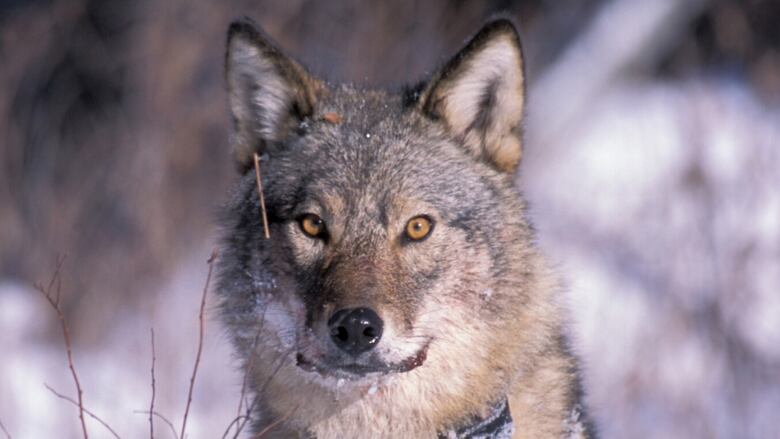Algonquin Park public wolf howls cancelled 2 years in a row
Both natural and human factors may play a role in cancellations at Ontario provincial park

The chance to hear the eerie howl of a wild wolf draws tourists from around the world to Canada's Algonquin Park.
But for the past two years, those hoping to take part in a public wolf howl have been disappointed, as the events have been cancelled.
As part of the event, naturalists howl into the woods along the main highway that runs through the central Ontario provincial park, and members of the public listen for the response of eastern wolves – yipping and yapping from the pups, and deeper, longer howls from the adults, as can be heard in a YouTube video by Stephen J. Stephen Photography.
"It's thrilling to be able to hear," said Rick Stronks, the chief park naturalist who organizes the events.
He has heard wolves howling hundreds of times, but never gets tired of it.
Unfortunately, Algonquin Park cancelled all five of its potential public wolf howls this year, saying no suitable wolf pack was located for the events. It marked the second year in a row for no public wolf howls.
Stronks says the public wolf howl may be the biggest naturalist-led interpretive program in the entire world — each one can draw more than 2,000 people.

"People really do come from all over the world hoping to hear this," he said. "There's something very eerie, something very primitive about that sound that really maybe just connects us back to nature."
Typically, he said, around five packs live along Highway 60. When a wolf howl is planned, naturalists go out earlier in the week to do some test howling along the highway. If wolves howl back, it usually indicates that a pack has chosen a "rendez-vous" or regrouping site near the highway. In late summer, that's where the adults leave their pups while they go hunting.
When humans howl, often the pups respond first.
"They likely are thinking that an adult is coming back, maybe with food," Stronks said.
Naturalists not concerned
He said not finding a suitable pack for a public wolf howl for two years is a bit unusual, but not completely unheard of in the program's 52-year history.
"That's why we're not concerned," he said.

Brent Patterson is a biologist with the government of Ontario and an adjunct professor at Trent University who studies eastern wolves, which are considered species of concern in Ontario and across Canada. Algonquin Park, which is more than 7,600 square kilometres, is the largest protected area within their range, and is home to about 35 packs.
He says there's no reason to think the wolf howl cancellations indicate declining populations.
The average wolf pack in the park roams a huge territory of about 125 to 150 square kilometres.
Some years, it may be that all the wolves are in a part of their territory far from the highway.
"Other years, there might be multiple packs close to the highway," he said.

The wolves may be drawn to different areas in different years due to changes in the environment, such as the breakage of a beaver dam or the drying up of a beaver pond, which can change the availability of prey such as beavers.
Or they might choose different areas depending on who is leading the pack, Patterson said.
"One of the breeding adults might lead the pack to use the same area, but if that animal dies or leaves the pack, new animals that take over leadership, might want to direct activity elsewhere."
Human factors
Stronks said there are also human factors to consider.
Because the event draws hundreds of cars, the events need to take place along stretches of the highway that can accommodate them. Not only does there need to be space for 1.5 kilometres of cars parked bumper to bumper on both sides of the highway, but there can't be rock cuts or hills in the vicinity that could block some of the participants from hearing the wolves' responses as they stand beside their cars. Nor can there be wind or rain that makes it harder to hear.

During the past two years, there was some highway construction that limited the locations that could be used for the huge public wolf howls.
The events can't be held too closely to places such as campsites, either, which ruled out a couple of packs that were around this year.
But Stronks was still able to take smaller groups of 10 or 15 people on successful wolf howls as recently as last week.
Patterson said a number of wolves in the park wear radio-tracking collars, and some have been travelling fairly near the highway corridor "but haven't been at the right place at the right time to be picked up by the howls."
He added that this winter, his team plans to ramp back up its park-wide wolf population monitoring program after a five-year lull. Researchers will then have more detailed data about the number of wolves and their distribution within the park.
In the meantime, there's reason to be optimistic for next year.
Stronks says the events have usually not been cancelled for more than two years in a row.
Corrections
- A previous version of this story incorrectly called eastern wolves a subspecies of the grey wolf. In fact, they were recently recognized as a distinct species.Sep 14, 2015 12:04 PM EDT